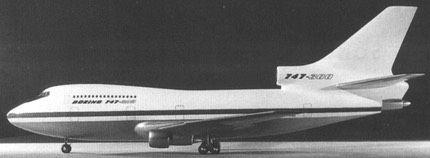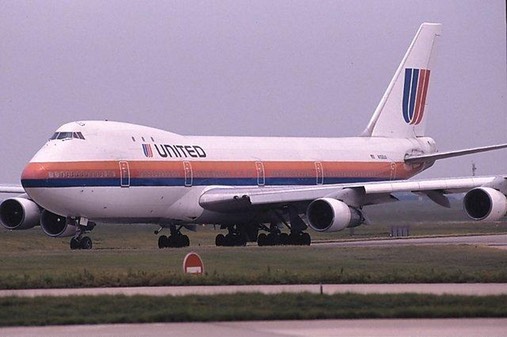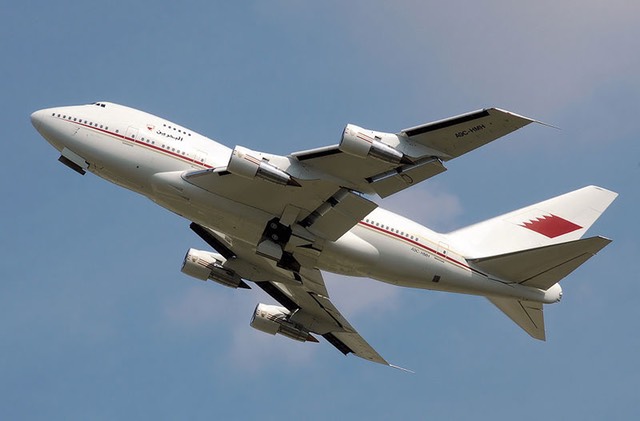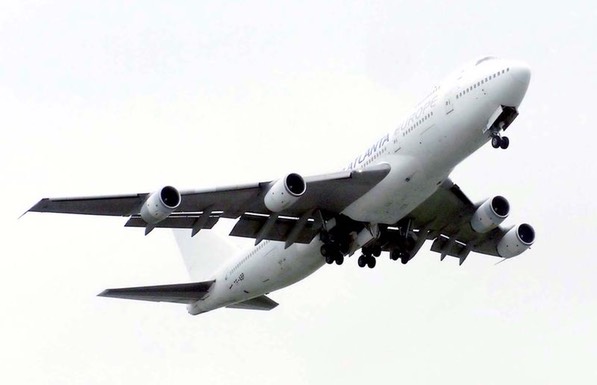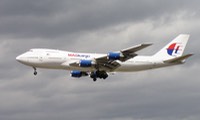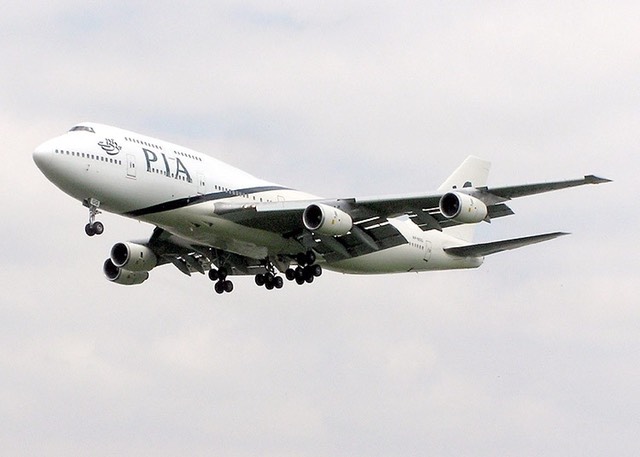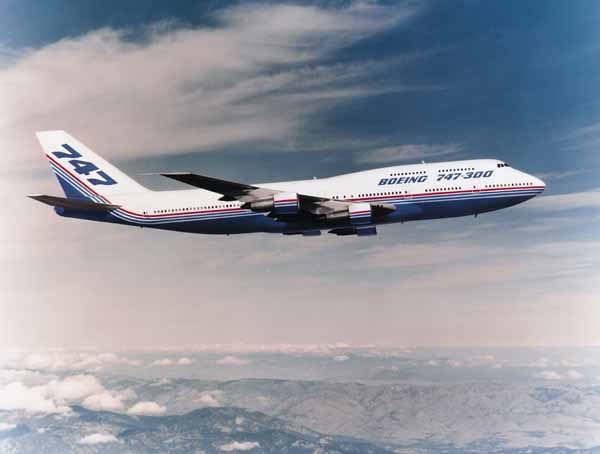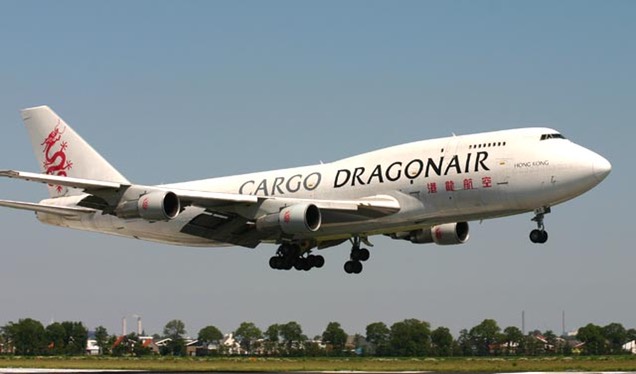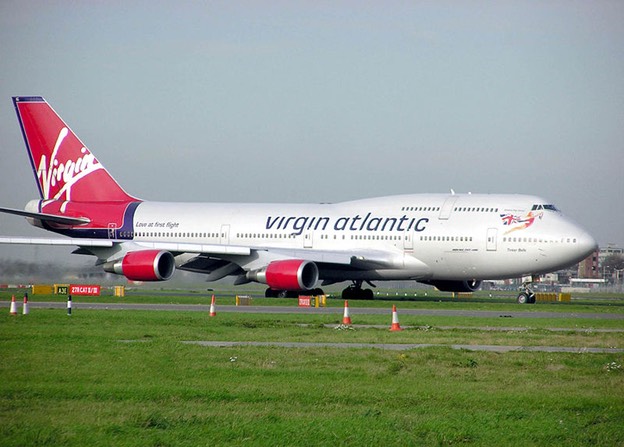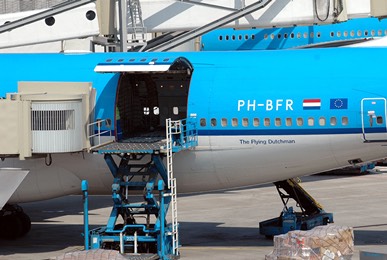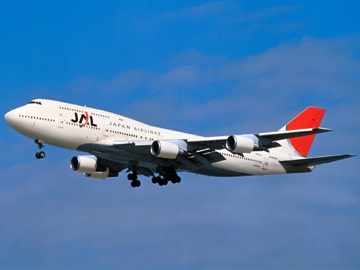Boeing 747 Family
- 747-100
- 747-100B
- 747-100F
- 747-100SR
- 747-100SP
- 747-200
- 747-200B
- 747-200C
- 727-200F
- 747-200M
- 747-300
- 747-300SR
- 747-300M
- 747-400
- 747-400F
- 747-400C
- 747-400M (Combi)
- 747-400D
- 747-400ER
- 747-400ERF
- 747-400BCF
- 747-400XQLR
- 747-8
- 747-8F
- 747-8i
- Yellowstone Project
- Boeing 747-500X, -600X and -700X (never produced)
- 747 Trijet
The Boeing 747 is a widebody commercial airliner, often referred to by the nickname "Jumbo Jet". It is among the world's most recognizable aircraft,and was the first widebody ever produced. Manufactured by Boeing's Commercial Airplane unit in the US, the original version of the 747 was two and a half times the size of the Boeing 707, one of the common large commercial aircraft of the 1960s. First flown commercially in 1970, the 747 held the passenger capacity record for 37 years.
The four-engine 747 uses a double deck configuration for part of its length. It is available in passenger, freighter and other versions. Boeing designed the 747's hump-like upper deck to serve as a first class lounge or (as is the general rule today) extra seating, and to allow the aircraft to be easily converted to a cargo carrier by removing seats and installing a front cargo door. Boeing did so because the company expected supersonic airliners, whose development was announced in the early 1960s, to render the 747 and other subsonic airliners obsolete, but that the demand for subsonic cargo aircraft would be robust into the future. The 747 in particular was expected to become obsolete after 400 were sold but it exceeded its critics' expectations with production passing the 1,000 mark in 1993. As of October 2008, 1,409 aircraft had been built, with 115 more in various configurations on order.
The 747-400, the latest version in service, is among the fastest airliners in service with a high-subsonic cruise speed of Mach 0.85 (567 mph or 913 km/h). It has an intercontinental range of 7,260 nautical miles (8,350 mi or 13,450 km). The 747-400 passenger version can accommodate 416 passengers in a typical three-class layout or 524 passengers in a typical two-class layout. The next version of the aircraft, the 747-8, is in development, and scheduled to enter service in 2010. The 747 is to be replaced by the Boeing Y3 (part of the Boeing Yellowstone Project) in the future.
747 Delivery Timeline (Wikipedia Images)
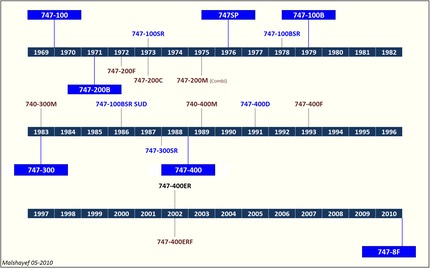
747-100
The first 747-100s were built with six upper-deck windows (three per side) to accommodate upstairs lounge areas. Later, as airlines began to use the upper-deck for premium passenger seating instead of lounge space, Boeing offered a 10-window upper deck as an option. Some -100s were retrofitted with the new configuration.
| Developing nation: | United States of America. |
| Manufacturer/designer: | Boeing Commercial Airplane Company. |
| Production line: | Everett, WA. |
| Type aircraft: | Long range high capacity wide body airliner. |
| First flight: |
- 747-100 February 9, 1969, N7470. - 747-200B October 11, 1970, N611US. - 747-200F November 30, 1971, N1794B. - 747-200C March 23, 1973, N747WA. - 747SP July 4, 1975, N747SP. - 747-200M November 18, 1974, N8297V. - 747-300/SR October 5, 1982 N6005C. - 747-300M February 14, 1983, N4548M. - 747-400 April 29, 1988, N401PW. - 747-400M June 30, 1989, N6038E. - 747-400D March 18, 1991, N60668. - 747-400F May 4, 1993, N6005C. - 747-400ER July 31, 2002, N6018N. - 747-400ERF September 30, 2002, N5017Q. |
| First delivery: |
- 747-100 December 13, 1969 to Pan Am. - 747-200B January 15, 1971 to KLM. - 747-200F March 10, 1972 to Lufthansa. - 747-200C April 30, 1973 to World Airways. - 747SP March 5, 1976 to Pan Am. - 747-200M March 7, 1975 to Air Canada. - 747-300/SR March 1, 1983 to UTA. - 747-300M March 5 1983 to Swissair. - 747-400 January 26, 1989 to Northwest Airlines. - 747-400M September 1, 1989 to KLM. - 747-400D October 10, 1991 to Japan Air Lines. - 747-400F October 22, 1993 to Cargolux. - 747-400ER October 31, 2002 to Qantas. - 747-400ERF. October 17, 2002 to Air France. |
| Last delivery: |
- 747-100 July 1986 to Japan Air Lines. - 747-200B December 1990 to USAF. - 747-200F November 1991 to Nippon Cargo Airways. - 747-200C September 1988 to Martinair. - 747SP December 12, 1989 to Abu Dhabi Government (UAE). - 747-200M December 12, 1989 to Abu Dhabi Government (UAE). - 747-300/SR October 1988 to Japan Asia. - 747-300M September 1990 to SABENA. - 747-400M April 10, 2002 to KLM. - 747-400D December 1995 to All Nippon Airways. |
| Boeing 747-100 | |
| Cockpit crew: | two pilots and a flight engineer. |
| Passengers single class: | - 539. |
| Passengers two class main deck: |
- 32 first class. - 388 economy class. |
| Passengers three class main deck: |
- 22 first class. - 84 business class. - 131 economy class. |
| Upper deck seating options: |
- 15 place lounge. - 8 first class plus 11 place lounge. - 16 first class sleeper seats. - 32 - 45 economy class. |
| Cabin length: | 57,00 m. |
| Cabin diameter: | 6,13 m. |
| Cabin height: | 2,54 m. |
| Cabin volume: | 516 m³. |
| Baggage compartment: | 28,3 m³. |
| Cargo volume: |
- main deck 516 m³. - under floor 149,96 m³. - bulk under floor 28,3 m³. - total load 694 m³. |
| LD3 Containers in belly: | 30. |
| Standard 2.24m x 3.18m pallets: |
- main cargo deck of freighter 28. |
| Standard 2.24m x 2.99m pallets: |
- main cargo deck of freighter 30. |
| Wing span: | 59,64 m. |
| Wing area: | 510,97 m². |
| Wing sweep: | 37.5 degrees. |
| Fuselage length: | 70,66 m. |
| Fuselage diameter: | 6,49 m. |
| Height: | 19,33 m. |
| Horizontal tail unit: | 22,17 m. |
| Wheelbase: | 25,62 m. |
| Track: | 10,36 m. |
| Engines: |
- four Pratt & Whitney JT9D-3A each rated 19.730 kg thrust. - four Pratt & Whitney JT9D-3AW each rated 19.730 kg thrust. - four Rolls Royce RB211-524C2 each rated 224,8 kN. |
| Weight: |
- empty: 171.840 Kg. - max. zero-fuel weight: 247.170 Kg. - fuel: 181.950 liters. - max. payload: 76.280 Kg. |
| Max. take off weight: | 340.100 Kg. |
| Max. landing weight: | 265.300 Kg. |
| Cruise speed: | 957 km/h. |
| Max. speed: | 991 km/h. |
| Landing speed: | 259 km/h. |
| Max. ceiling: | 13.716 m. |
| Range: |
9.045 km. |
|
Boeing 747-100 airline operators: |
|
| Saudi Arabian Airlines. |
- 7 747-168B - 1 747-1D1 |
| United Parcel Service. |
- 3 747-121SF - 4 747-123SF |
| Kalitta Air. |
- 2 747-122SF - 1 747-123SF - 1 747-132SF - 4 747-146SF |
| Evergreen International Airlines. |
- 2 747-132SF - 1 747-121SF |
| Kabo Air. |
- 2 747-136 |
| Orient Thai Airlines. | - 2 747-146 |
| General Electric. | - 1 747-121SF |
| Iran Air. | - 1 747-186B |
| Logistic Air. | - 1 747-121 |
| NASA. | - 1 747-123 |
| Polar Air Cargo. | - 1 747-123SF |
| Saha Airline Services. | - 1 747-131SF |
|
Boeing 747-100 military operator: |
|
| Iran Air Force. |
- 5 747-131SF - 1 747-131F |
747-100B
A 747-100B version, which has a stronger airframe and undercarriage design as well as an increased maximum takeoff weight (MTOW) of 750,000 lb (340,000 kg) was offered. The 747-100B was delivered only to Iran Air and Saudia (now Saudi Arabian Airlines). Optional engine models were offered by Rolls-Royce (RB211) and GE (CF6), but only Saudia ordered the Rolls-Royce option.
747-100F
| Boeing 747-100F | |
| Upper deck seating options: |
- 3 place crew lounge. |
| Cargo volume: |
- main deck 516 m³. - under floor 149,96 m³. - bulk under floor 28,3 m³. - total load 694 m³. |
| LD3 Containers in belly: | . |
| Standard 2.24m x 3.18m pallets: |
- main cargo deck of freighter 28. |
| Standard 2.24m x 2.99m pallets: |
- main cargo deck of freighter 30. |
| Engines: |
- four Pratt & Whitney JT9D-7A each rated 205,3 kN. |
| Weight: |
- empty: 173.010 Kg. - max. zero-fuel weight: 238.780 Kg. - fuel: 183.360 liters. - max. payload: 65.770 Kg. |
| Max. take off weight: | 333.300 Kg. |
| Max. landing weight: | 255.800 Kg. |
747-100SR
Responding to requests from Japanese airlines, Boeing developed the 747-100SR as a "short range" variant of the 747-100. The SR has a lower fuel capacity but can carry more passengers, up to 498 in early versions and more than 550 in later models, because of increased economy class seating. The 747SR has a modified body structure to accommodate the added stress accumulated from a greater number of takeoffs and landings. The -100SR entered service with Japan Airlines (then Japan Air Lines) on 7 October 1973. Specifically, the SR has extra structural support at the wings, fuselage, and the landing gear along with a 20% reduction in fuel capacity. Later, short range versions of the -100B and the -300 were also developed. The SRs are used primarily on domestic flights in Japan.
Two 747-100B/SRs were delivered to Japan Airlines (JAL) with a stretched upper deck to accommodate more passengers. This modification is known as the "SUD" (stretched upper deck).
All Nippon Airways (ANA) operated 747SRs on domestic Japanese routes with 455 or 456 seats but retired the last aircraft on 10 March 2006. JAL operated the 747-100B/SR/SUD variant with 563 seats on domestic routes, and retired these planes in the third quarter of 2006. JAL and JALways have operated the -300SRs on domestic leisure routes and to other parts of Asia.
| Boeing 747-100SR | |
| Passengers single class: | 550 |
| Engines: |
- four Pratt & Whitney JT9D-7A each rated 205,3 kN. - two General Electric CF6-45A2 each rated 202,8 kN. |
| Weight: |
- empty: 164.510 Kg. - max. zero-fuel weight: 219.950 Kg. - fuel: 183.360 Kg. - max. payload: 57.060 Kg. |
| Max. take off weight: | 272.100 Kg. |
| Max. landing weight: | 255.800 Kg. |
747-100SP
The idea for The 747SP came from a joint request between Pan American World Airways and Iran Air who were looking for a high capacity airliner with enough range to cover Pan Am's New York-Middle Eastern routes and Iran Air's planned Tehran-New York route. The Tehran-New York route when launched was the longest nonstop commercial flight in the world. The 747SP is 48 feet 4 inches (14.7 m) shorter than the 747-100. Except for the planned 747-8, the SP is the only 747 with a fuselage of modified length. Fuselage sections were eliminated fore and aft of the wing, and the center section of the fuselage was redesigned. Single-slotted flaps replaced the complex triple-slotted Fowler flaps of the 100 series.[112] The under-wing "canoes", which housed the flap mechanisms on full-size 747s, were eliminated entirely on the SP. The 747SP, compared to earlier variants, had a tapering of the aft upper fuselage into the empennage, a double-hinged rudder, and longer vertical and horizontal stabilizers.
The 747SP was granted a supplemental certificate on 4 February 1976 and entered service with Pan American, the launch customer and Iran Air, that same year. The aircraft was chosen by airlines wishing to serve major airports with short runways.
A total of forty-five 747SPs were built. The 44th 747SP was delivered on 30 August 1982. Boeing re-opened the 747SP production line to build one last 747SP five years later in 1987 for an order by the United Arab Emirates government.[113] As of August 2007, 17 Boeing 747SP aircraft were in service with Iran Air (3), Saudi Arabian Airlines, Syrian Arab Airlines (2) and as executive versions. NASA's Dryden Flight Research Center has one modified for the SOFIA experiment.
747-200
The 747-200 has more powerful engines, higher takeoff weights (MTOW), and range than the -100. A few early -200s retained the three-window configuration of the -100 on the upper deck, but most were built with a 10-window configuration on each side.
Several versions in addition to the -200 were produced. The 747-200B is an improved version of the 747-200, with increased fuel capacity and more powerful engines; it first entered service in February 1971. The -200B aircraft has a full load range of about 6,857 nmi (12,700 km). The 747-200F is the freighter version of the -200 model. It could be fitted with or without a side cargo door. It has a capacity of 105 tons (95.3 tonnes) and an MTOW of up to 833,000 lb (378,000 kg). It entered first service in 1972 with Lufthansa. The 747-200C Convertible is a version that can be converted between a passenger and a freighter or used in mixed configurations. The seats are removable, and the model has a nose cargo door.[119] The -200C could be fitted with an optional side cargo door on the main deck.
The 747-200M is a combination version that has a side cargo door on the main deck and can carry freight in the rear section of the main deck. A removable partition on the main deck separates the cargo area at the rear from the passengers at the front. This model can carry up to 238 passengers in a 3-class configuration if cargo is carried on the main deck. The model is also known as the 747-200 Combi.As on the -100, a stretched upper deck (SUD) modification was later offered. A total of 10 converted 747-200s were operated by KLM. UTA French Airlines also had two of these aircraft converted.
A total of 393 of the -200 versions had been built when production ended in 1991. Of these, 225 were 747-200s, 73 were 747-200F, 13 were 747-200C, 78 were 747-200M, and 4 were military. Many 747-200s are still in operation, although most large carriers have retired them from their fleets and sold them to smaller operators. Large carriers have sped up fleet retirement following the September 11th attacks and the subsequent drop in demand for air travel, scrapping some or turning others into freighters
747-200B
The 747-200B is an improved version of the 747-200, with increased fuel capacity and more powerful engines; it first entered service in February 1971. The -200B aircraft has a full load range of about 6,857 nmi (12,700 km). The 747-200F is the freighter version of the -200 model. It could be fitted with or without a side cargo door. It has a capacity of 105 tons (95.3 tonnes) and an MTOW of up to 833,000 lb (378,000 kg). It entered first service in 1972 with Lufthansa.
| Boeing 747-200B | |
| Cockpit crew: | two pilots and a flight engineer. |
| Passengers single class: | - 539. |
| Passengers two class main deck: |
- 32 first class. - 388 economy class. |
| Passengers three class main deck: |
- 22 first class. - 84 business class. - 131 economy class. |
| Upper deck seating options: |
- 15 place lounge. - 8 first class plus 11 place lounge. - 16 first class sleeper seats. - 32 - 45 economy class. |
| Cabin length: | 57,00 m. |
| Cabin diameter: | 6,13 m. |
| Cabin height: | 2,54 m. |
| Cabin volume: | 516 m³. |
| Baggage compartment: | 28,3 m³. |
| Cargo volume: |
- main deck 516 m³. - under floor 149,96 m³. - bulk under floor 28,3 m³. - total load 694 m³. |
| LD3 Containers in belly: | 30. |
| Standard 2.24m x 3.18m pallets: |
- main cargo deck of freighter 28. |
| Standard 2.24m x 2.99m pallets: |
- main cargo deck of freighter 30. |
| Wing span: | 59,64 m. |
| Wing area: | 510,97 m². |
| Wing sweep: | 37.5 degrees. |
| Fuselage length: | 70,66 m. |
| Fuselage diameter: | 6,49 m. |
| Height: | 19,33 m. |
| Horizontal tail unit: | 22,17 m. |
| Wheelbase: | 25,62 m. |
| Track: | 10,36 m. |
| Engines: |
- four Pratt & Whitney JT9D-7AW each rated 205.3 kN. - four Pratt & Whitney JT9D-7J each rated 222.4 kN. - four Pratt & Whitney JT9D-7R4G2 each rated 243.5 kN. - four General Electric CF6-50E2 each rated 230.4 kN. - four Rolls Royce RB211-524D4 each rated 231.3 kN. |
| Weight: |
- empty: 170.600 Kg. - max. zero-fuel weight: 238.780 Kg. - fuel: 198.370 liters. - max. payload: 68.180 Kg. |
| Max. take off weight: | 377.800 Kg. |
| Max. landing weight: | 285.700 Kg. |
| Cruise speed: | 939 km/h. |
| Max. speed: | 969 km/h. |
| Landing speed: | 259 km/h. |
| Max. ceiling: | 13.716 m. |
| Range: |
13.149 km. |
| Performance: |
- take-off run 3.170 m at max. take-off weight. - landing run 2.121 m at max. landing weight. |
747-200C
The 747-200C Convertible is a version that can be converted between a passenger and a freighter or used in mixed configurations. The seats are removable, and the model has a nose cargo door. The -200C could be fitted with an optional side cargo door on the main deck.
| Boeing 747-200C | |
| Upper deck seating options: |
- 15 place lounge. - 8 first class plus 11 place lounge. - 16 first class sleeper seats. - 32 - 45 economy class. |
| Engines: |
- four Pratt & Whitney JT9D-7AW each rated 205.3 kN. - four Pratt & Whitney JT9D-7FW each rated 213.5 kN. - four Pratt & Whitney JT9D-7Q each rated 235.75 kN. - four General Electric CF6-50E2 each rated 243.5 kN. |
| Weight: |
- empty: 164.030 Kg. - max. zero-fuel weight: 267.570 Kg. - fuel: 198.370 liters. - max. payload: 130.340 Kg. |
| Max. take off weight: | 377.800 Kg. |
| Max. landing weight: | 285.700 Kg. |
727-200F
| Boeing 747-200F | |
| Upper deck seating options: |
- 3 place crew lounge. - 20 economy class seats. |
| Cargo volume: |
- main deck 516 m³. - under floor 149,96 m³. - bulk under floor 28,3 m³. - total load 694 m³. |
| LD3 Containers in belly: | 30. |
| Standard 2.24m x 3.18m pallets: |
- main cargo deck of freighter 28. |
| Standard 2.24m x 2.99m pallets: |
- main cargo deck of freighter 30. |
| Engines: |
- four Pratt & Whitney JT9D-7AW each rated 205.3 kN. - four Pratt & Whitney JT9D-7FW each rated 213.5 kN. - four Pratt & Whitney JT9D-7Q each rated 235.75 kN. - four General Electric CF6-50E2 each rated 243.5 kN. - four Rolls Royce RB211-524D4 each rated 231.3 kN. |
| Weight: |
- empty: 155.180 Kg. - max. zero-fuel weight: 267.570 Kg. - fuel: 198.370 liters. - max. payload: 112.390 Kg. |
| Max. take off weight: | 377.800 Kg. |
| Max. landing weight: | 285.700 Kg. |
747-200M
The 747-200M is a combination version that has a side cargo door on the main deck and can carry freight in the rear section of the main deck. A removable partition on the main deck separates the cargo area at the rear from the passengers at the front. This model can carry up to 238 passengers in a 3-class configuration if cargo is carried on the main deck. The model is also known as the 747-200 Combi. As on the -100, a stretched upper deck (SUD) modification was later offered. A total of 10 converted 747-200s were operated by KLM. UTA French Airlines also had two of these aircraft converted.
747-300
The 747-300 entered commercial service in 1983, and was the first to integrate the most significant changes of the 747 Classics. These changes included an extended upper deck and improved engines with a reduced fuel burn of 25 percent per passenger. In addition, passenger capacity increased 10 percent by extending the upper deck and relocating the new straight stairway to the rear of the upper deck (prior models had a spiral-shaped staircase in the center of the upper deck). Boeing delivered 81 747-300s in passenger, combi and short-range configurations, the last in 1990.
The most visible difference between the -300 and previous models was a stretched upper deck with two new emergency exit doors and an optional flight-crew rest area immediately aft of the flight deck as standard. (The stretched upper deck had previously been offered as a retrofit and first appeared on two Japanese 747-100 SR models.) Compared to the -200, the upper deck is 23 feet 4 inches (7.11 m) longer than the -200. A new straight stairway to the upper deck instead of a spiral staircase is another difference between the -300 and earlier variants.[69] The staircase creates room below and above for more seats. With minor aerodynamic changes, Boeing increased the cruise speed of the -300 to Mach 0.85 from Mach 0.84 on the -100/-200. The -300 features the same takeoff weight. Two of the three engine choices from the -200 were unchanged in the -300, but the General Electric CF6-80C2B1 was offered instead of the CF6-50E2 offered on the -200.
The 747-300 name, which was proposed for a variant that was never launched, was revived for this new version, which was introduced in 1980. Swissair ordered the first 747-300 on 11 June 1980. The 747-300 first flew on 5 October 1982. Swissair was the first customer to accept delivery on 23 March 1983.
In addition to the passenger version, other versions were available. The 747-300M has cargo capacity in the rear portion of the main deck similar to the -200M, but with the stretched upper deck it can carry more passengers. The 747-300SR is a short range version to meet the need for a high-capacity domestic model. Japan Airlines operated such aircraft with more than 600 seats on the Okinawa–Tokyo route and elsewhere. Boeing never launched a newly built freighter version of the 747-300, but it modified used passenger -300 models into freighters starting in 2000.
A total of 81 aircraft were delivered, 56 for passenger use, 21 -300M and 4 -300SR versions. The 747-300 was soon superseded by the launch of the more advanced 747-400 in 1985, just two years after the -300 entered service. The last 747-300 was delivered in September 1990 to Sabena.
Today, many -300 aircraft are still active, despite a significant loss of interest in the series among large carriers who replaced the 747-300 with the 747-400. Air France and Qantas were some of the last major carriers to operate the 747-300. On 29 December 2008, Qantas flew its last scheduled 747-300 service, operating from Melbourne to Los Angeles via Auckland. On 20 January 2009, Qantas' last 747-300 was flown to the United States for storage. Carriers still using the -300 include Japan Airlines and Saudi Arabian Airlines. Although none were constructed as dedicated freighters, a few -300s have been converted to cargo operations.
747-300SR
The 747-300SR is a short range version of the 300 to meet the need for a high-capacity domestic model. Japan Airlines operated such aircraft with more than 600 seats on the Okinawa–Tokyo route and elsewhere. Boeing never launched a newly built freighter version of the 747-300, but it modified used passenger -300 models into freighters starting in 2000
747-400
The 747-400 was announced by Boeing Commercial Airplanes in October 1985. Compared to the 747-300 the 747-400 has 6 feet (1.8 m) wing tip extensions and 6 feet (1.8 m) winglets, and a glass cockpit which dispensed with the need for a flight engineer. The 747-400 also improved on the -300 with tail fuel tanks, revised engines, an all-new interior, revised fuselage/wing fairings and newer in-flight entertainment. Like the 747-300, the passenger version of the 747-400 included the stretched upper deck (SUD) as a standard feature. The SUD was almost twice as long as the standard upper deck. It had previously been offered as a retrofit and first appeared on two Japanese 747-100 SR models. While the wingspan was increased, the overall weight of the wings was decreased due to the use of composites and aluminum alloys.
It was rolled out in January 1988 and first flew on 29 April 1988. Certification was received on 10 January 1989 with Pratt & Whitney PW4000 engines, 18 May 1989 with CF6-80C2s and 8 June 1989 with Rolls-Royce RB211-524Gs. The first 747-400 was delivered to Northwest Airlines on 26 January 1989, with service entry on 9 February.
The extended range freighter (ERF) entered service in October 2002. The next month, the extended range (ER) passenger version entered service with Qantas, the only airline ever to order the passenger version of the 747-400ER. Qantas uses the aircraft on its Melbourne-Los Angeles and Sydney-San Francisco flights, which are too long to operate using a standard 747-400.
The Boeing Signature Interior was later made available on the 747-400, either as interior refitting on existing 747-400s or as a "fresh-from-installation" option on newer 747-400s and 747-400ERs. One example, China Airlines's four newest Boeing 747-400s (tail number B-1821x), also the last four passenger 747-400s built, were newly built with Boeing Signature Interior. One of these (B-18210) has a hybrid livery, with China Airlines' tail and Boeing's fuselage liveries.
The 747-400 is an improved version of the 747-300 with increased wingspan, winglets, revised engines and a glass cockpit that removed the need for a flight engineer. The 747-400 passenger version features a stretched upper deck (SUD) like the 747-300 as a standard feature. In 1989, a Qantas 747-400 flew non-stop from London to Sydney, a distance of 9,720 nmi (11,190 mi, 18,000 km) in 20 hours and 9 minutes, although this was a delivery flight with no commercial passengers or freight aboard and using extra dense jet aviation fuel produced specially by Shell.
Production of the 747-400 passenger version officially ceased on 15 March 2007.The last four -400s on order were canceled by Philippine Airlines (which switched to the 777-300ER). The last to order the -400 was China Airlines in November 2002, with the last passenger 747-400 constructed in 2005 and delivered in April of that year. It was the 1358th 747 (MSN33737/B-18215).
747-400F
The 747-400F (Freighter) is an all freight version which uses the fuselage design of the 747-200F. The aircraft's first flight was on 4 May 1993 and it entered service with Cargolux Airlines on 17 November 1993. Major customers include Atlas Air, Cargolux, China Airlines, Korean Air, Nippon Cargo Airlines, Polar Air Cargo, and Singapore Airlines. The -400F can be easily distinguished from the passenger -400 by its shorter upper-deck hump.
The United States Air Force has purchased seven 747-400Fs to act as "Airborne Laser" carriers, designated YAL-1A. The aircraft are heavily modified to carry a nose mounted turret and Chemical Oxygen Iodine Laser (COIL) equipment.
747-400C
The 747-400C does not actually exist its actually the 747-400M which stands for "Mixed". There may have been some confusion with the C designation as cargo. The M series goes under the name Combi.
747-400M (Combi)
Since its introduction in 1975, the Boeing 747 Combi has helped airlines around the world meet their long-range passenger and cargo requirements. The combi has a large side-cargo door behind the left wing, plus equipment that removes passenger seats and installs cargo tracks, giving airlines the option of carrying cargo in containers on the main deck behind passengers. This flexibility allows airlines to adapt the interior configuration to meet variations in seasonal markets and charter demands.
Another reason for the combi's popularity is that it can be scheduled through an airport with the same turnaround time as any other passenger 747. Cargo operations do not interfere with passenger service, because main-deck cargo loading occurs in an area of the airplane where normally there is no activity. This simultaneous passenger-and-cargo-loading/unloading operation is possible because of the stability allowed by the fore and aft arrangement of the wing and body landing gear.
The large side-cargo door on the main deck allows cargo loading in the aft section at the same time passengers are boarded in the forward section. A locked partition separates the passenger compartment from the cargo area, accessible only by the crew. Roller trays on the 747's aft floor facilitate loading of 8-foot-wide (2.4 m) containers, or pallets, up to 20 feet long (6.1 m). The airplane's main deck can accommodate any container or pallet used in the aviation industry today in lengths of up to 20 feet (6.1 m).
The combi can handle large volume shipments such as automobiles, small boats, heavy machinery, drilling equipment and even small aircraft or helicopters. Environmental control in the cargo area allows transportation of live animals, perishable foods and cut flowers/vegetables, while maintaining separate environmental control of the passenger cabin. The 747-400 Combi incorporates additional fire protection, a two-crew digital flight deck, advanced engines, wingtip extension with winglet and new interiors. The first customer for the 747-400M Combi was KLM Royal Dutch Airlines. The stretched upper deck of the 747-300 and 747-400 Combis can accommodate 44 more passengers than the standard 747-200 Combi. The 747-400 Combi is currently the only combi in production.
More than 30 customers operate a total of 144 747 Combis, including 58 747-400 Combis.
747-400D
The 747-400D (Domestic) is a high density seating model developed for short-haul domestic Japanese flights. The aircraft is capable of seating a maximum of 568 passengers in a 2-class configuration or 660 passengers in a single-class configuration. The -400D lacks the wing tip extensions and winglets included on other variants, allowing for increased number of takeoffs and landings by lowering wing stresses. The benefits of winglets would be minimal on short routes. The -400D may be converted to the long range version when needed. The 747-400D is also unusual in having more windows on both sides of the upper deck than the basic -400 series (2 portside, 4 starboard). The aircraft does not have extra fuel tanks and
The 747-400 Domestic first flew on 18 March 1991 and entered service with Japan Airlines on 22 October 1991. The last was delivered to All Nippon Airways in December 1995. 19 747-400D were built primarily for the Japanese market.
747-400ER
The 747-400ER (Extended range) was launched on 28 November 2000 following an order by Qantas for 6 aircraft. This was ultimately the only order for the passenger version. The -400ER can fly an additional 805 km or carry 6,800 kg more freight. Qantas received the first -400ER on 31 October 2002.
The 747-400ER includes the option of 1 or 2 additional 3,240 US gallon body fuel tanks in the forward cargo hold. Manufactured by Marshall Aerospace, these tanks utilize innovative metal to metal honeycomb bonded technology to achieve an incredibly high dry weight to fuel volume ratio. Similar technology has been used in the development by Marshall of body fuel tanks for the 777-200LR and P-8A Poseidon MMA aircraft.
747-400ERF
The 747-400ERF is the freight version of the -400ER, launched on 30 April 2001.[7] The -400ERF was delivered to Air France (via ILFC) on 17 October 2002. The 747-400ERF has a maximum payload of 248,600 pounds (112,760 kg)(maximum takeoff weight is 910,000 pounds) and offers the cargo airline the choice of either adding 22,000 pounds (9,980 kg) more payload than other 747-400 freighters, or adding 525 nautical miles (972 km) to the maximum range.[8] It has a maximum range of 9,200 km, about 525 km farther than other 747-400 freighters, and has a strengthened fuselage, landing gear and parts of its wing, along with new, larger tires.
Boeing has seven 747-400ERF aircraft yet to be delivered in June 2008. The new 747-8 Freighter will have more payload capacity but less range than the 747-400ERF.
747-400BCF
The 747-400BCF (Boeing Converted Freighter), formerly known as the 747-400SF (Special Freighter), is a conversion program for standard passenger 747-400s. The project was launched in 2004. The first Boeing 747-400BCF was redelivered to Cathay Pacific Cargo and entered service on 19 December 2005.
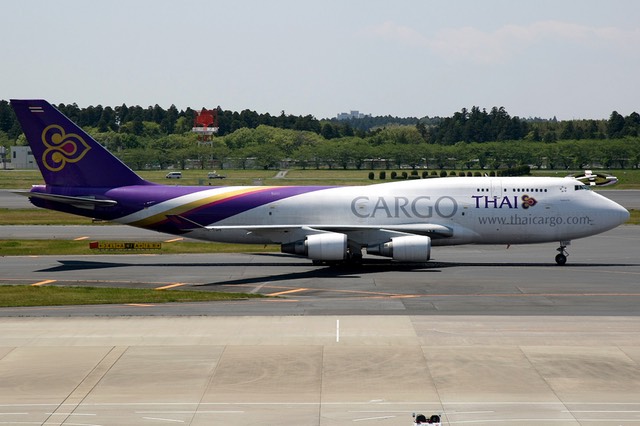
747-400XQLR
Announced at the Asian Aerospace 2002 show in Singapore and supposed to enter service in 2004. The development of the plane was abandoned and effort was put into the 747-8.
Following the termination of the 747X program, Boeing continued to study improvements which could be made to the aircraft. The 747-400XQLR (Quiet Long Range) would have featured longer range than the 747-400ER, at 7980 nm (14,800 km), along with improvements to improve efficiency and reduce noise.
The "X" in the title signified it as a variation of the 747-400. In order to make the new 747 more environmentally friendly, the engines were given new acoustic liners and were equipped with "chevron" shaped cowlings around the fan and core exhausts. The result was a 20% reduction in what is know as "noise area level" on takeoff and a decrease of 40% on landing as compared to the standard 400.
Other improvements included extra fuel storage in the horizontal tail tank and a gross weight increase from 910,000 pounds to 921,000. The QLR also spotted raked wingtips similar to those on the extended range 777 and the 767-400ER.
747-8
747-8 Images
The Boeing 747-8 is a widebody commercial airliner being developed by Boeing Commercial Airplanes. Officially announced in 2005, the 747-8 is the latest evolutionary variant of the Boeing 747, with lengthened fuselage, redesigned wings and improved efficiency. With a maximum take-off weight of 970,000 lb (440,000 kg), the 747-8 will be the heaviest aircraft, commercial or military, to be manufactured in the United States.
The first 747-8 freighter is due to be delivered in late 2010, with the passenger model currently scheduled for 2011.
Boeing announced that it was launching the 747 Advanced as the "Boeing 747-8" on 14 November 2005. The 747-8 and 747SP are the only 747 variants with a fuselage of modified length. This will be the first lengthened 747 to go in to production.
The 747-8 will use the same engine and cockpit technology as the 787. Boeing says that the new design will be quieter, more economical, and more environmentally friendly than previous versions of the 747. As a derivative of the already common 747-400, the 747-8 has the economic benefit of similar training and interchangeable parts.
The 747-8, as the current new development of Boeing's largest airliner, is notably in direct competition on long-haul routes with the A380, a full-length double-deck aircraft now in service. For airlines seeking very large passenger airliners, the two have been pitched as competitors on various occasions.
Production of the first 747-8 Freighter began in Everett in early August 2008. On 14 November 2008, Boeing announced a delay to the 747-8 program, citing limited availability of engineering resources within Boeing, design changes and the recent strike by factory workers. Delivery of the first 747-8 Freighter was rescheduled from late 2009 to the third quarter of 2010. The first 747-8 Intercontinental passenger jet delivery was rescheduled from late 2010 to the second quarter of 2011.
As of February, 2009, only one airline customer (Lufthansa) had ordered the 747-8I passenger model, and Boeing announced it was reassessing the 747-8 project. Chief executive Jim McNerney stated that continuation of the project was not a foregone conclusion. The company was assessing various options
The 747-8 is a development of the Boeing 747, which takes advantage of improvements in technology and aerodynamics. The two variants of the 747-8 were launched in 2005, and as of 2006 will both feature a fuselage stretch of 18.3 ft (5.6 m) over the 747-400, bringing the total length to 250 ft 2½ in (76.26 m). The stretch would mean that the 747-8 would be the world's longest passenger airliner, surpassing the Airbus A340-600 by 3.6 ft (1.1 m).
Compared to the 747-400, the main technical changes will be on the wing of the aircraft, which will undergo a complete design overhaul. The sweep and basic structure will be kept to contain costs, but the wing will be thicker and deeper, with the aerodynamics recalculated. The pressure distribution and bending moments will be different, with the new wing for the passenger version being planned to hold 64,225 US gal (243,120 l) of jet fuel, and the cargo aircraft 60,925 US gal (230,630 l). The new wing will have single-slotted outboard flaps and double-slotted inboard flaps. Raked wingtips, similar to the ones currently on the 777-200LR, 777-300ER, and 767-400ER models and the 787-8 and 787-9 design, will replace the winglets on the 747-400. These structures help reduce the wingtip vortices at the lateral edges of the wings, decreasing wake turbulence and drag and thereby increasing fuel efficiency.
The extra fuel capacity in the redesigned wing compared to the 747-400 obviates the need to radically change the horizontal tail unit to accommodate auxiliary tanks, further saving costs. Nonetheless, the vertical tail unit will be raised slightly to 64 feet 2 inches (19.6 m) on the 747-8. Some carbon fiber reinforced plastic will be utilized in the 747-8's airframe to reduce weight; however, structural changes will mostly be evolutionary rather than revolutionary with respect to the 747-400.
The General Electric GEnx, which is one of the two powerplant choices currently offered for the 787, will be the only engine available for the 747-8. However, the 747 variant will be adapted to provide bleed air for conventional aircraft systems and feature a smaller diameter to fit on the 747 wing. An exclusivity agreement between GE and Boeing means that no other manufacturer's engine can be fitted to the 747-8 within at least 10 years.
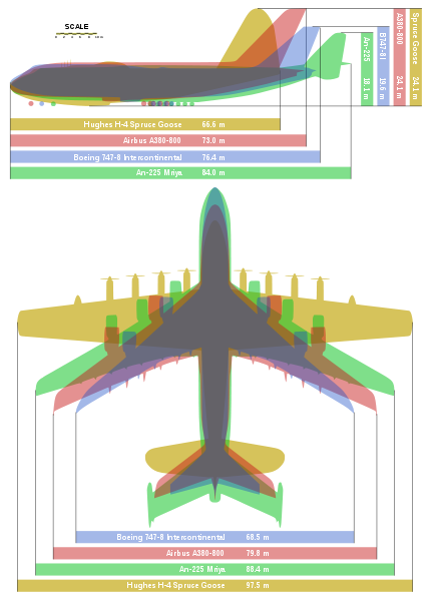
Size of the Boeing 747-8 compared to the Airbus A380 and AN-225.
747-8F
747-8F
The 747 has proven to be a very popular freighter, carrying around half of the world's air freight as of 2007. In an effort to maintain this dominant position, Boeing has developed a freight variant of the 747-8, dubbed 747-8 Freighter or 747-8F. The 747-8F will be the initial model to see entry into service (EIS). As on the 747-400F, the upper deck is shorter than passenger models; the 18 feet 3½ inches (5.58 m) stretch is just before and just aft of the wing. With a 970,000 lb (440,000 kg) maximum take-off weight, it will have a total payload capability of 308,000 lb (140,000 kg) and a range of 4,475 nmi (8,288 km).Four extra pallet spaces will be created on the main deck, with two extra containers and two extra pallets on the lower deck.
The 747-8F achieves a 16% lower ton-mile operating cost than the 747-400F and offer a slightly greater range. The 747-8F has more payload capacity but less range than the current 747-400ERF. When Boeing launched the ERF, all of the 35,000 lb (16,000 kg) increase in MTOW over the 747-400F 875,000–910,000 lb (397,000–413,000 kg)) allowed airlines to take off with more fuel, burn it during flight, and land at the same weight as the regular 747-400F. This increased the range of the 747-400ERF compared to the 747-400F. Cargo carriers such as Cargolux often move machinery or indivisible loads that require a plane with a higher payload and landing capability. As is common with cargo planes, range is given with maximum payload, not fuel. The 747-8's 60,000 lb (27,000 kg) MTOW increase (970,000 lb or 440,000 kg) has been directed exclusively to its Zero-Fuel weight or payload capacity. If taking off at maximum payload, the 747-8 takes off with its tanks roughly half empty. On trips where the payload is not at maximum, the plane can take on more fuel and extend its range.
747-8i
The Boeing 747-8 is a widebody commercial airliner being developed by Boeing Commercial Airplanes. Officially announced in 2005, the 747-8 is the latest evolutionary variant of the Boeing 747, with lengthened fuselage, redesigned wings and improved efficiency. With a maximum take-off weight of 970,000 lb (440,000 kg), the 747-8 will be the heaviest aircraft, commercial or military, to be manufactured in the United States.
The first 747-8 freighter is due to be delivered in late 2011, with the passenger model currently scheduled for 2011.
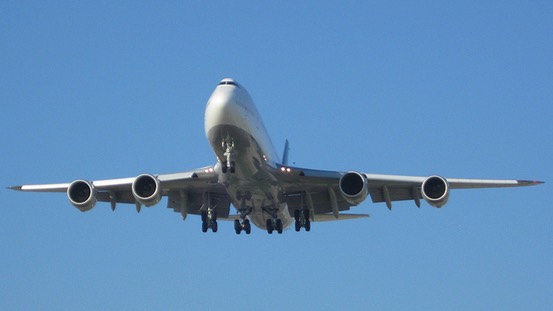
Boeing 747-8i
Thе 747-8 іѕ thе longest volume-production, fixed-wing commercial aircraft іn thе world. Onlу thе single flying Antonov An-225 Mriya, originally built tο piggy-back thе USSR’s Buran Space Shuttle аnd now carrying outsize freight loads throughout thе world, іѕ longer.
At 250 feet 2 inches (76.25 metres) іn length, thе Boeing 747-8 family іѕ 18 feet 4 inches (5.6 metres) longer thаn аnу οthеr version οf thе 747 еνеr built. Boeing achieved thе extra fuselage length bу installing a 13ft 4in (4.06m) fuselage plug ahead οf thе wing аnd a 5ft (1.52m) fuselage plug aft οf іt.
Yellowstone Project
Yellowstone is a Boeing Commercial Airplanes project to replace its entire civil aircraft portfolio with advanced technology aircraft. New technologies to be introduced include composite aerostructures, more electrical systems (reduction of hydraulic systems), and more fuel-efficient turbofan engines (such as the Pratt & Whitney PW1000G Geared Turbofan, General Electric GEnx, the CFM International LEAP56, and the Rolls-Royce Trent 1000). The term "Yellowstone" refers to the technologies, while "Y1" through "Y3" refer to the actual aircraft.
Yellowstone is divided into three projects:
- Boeing Y1, to replace the Boeing 737 product line. Y1 covers the 100- to 200-passenger market, and is expected to be the second Yellowstone Project aircraft to be developed. If launched, it will compete with the Bombardier CSeries and the planned Airbus NSR family.
- Boeing Y2, to replace the Boeing 767 product line. It may also replace the 777-200. Y2 initially referred to the highly efficient, more conventional, baseline aircraft for the Sonic Cruiser, which was project "Glacier".[3] It has now been built as the 787 and covers the 220- to 320-passenger market. It will compete with the Airbus A330, A340 and later A350 families.
- Boeing Y3, to replace the 777-300 and 747 product lines. Y3 covers the 300-400+ passenger market, and is expected to be the third Yellowstone Project aircraft to be developed. It will compete with the Airbus A380 family as well as the largest model of the A350 family, the A350-1000, which will be introduced in 2015.
Boeing 747-500X, -600X and -700X (never produced)
Boeing announced the 747-500X and -600X at the 1996 Farnborough Airshow. The proposed models would have combined the 747's fuselage with a new 251 ft (77 m) span wing derived from the 777. Other changes included adding more powerful engines and increasing the number of tires from two to four on the nose landing gear and from 16 to 20 on the main landing gear.
The 747-500X concept featured an 18 ft (5.5 m) stretch to 250 ft (76.2 m) long, and the aircraft was to carry 462 passengers over a range up to 8,700 nautical miles (10,000 mi, 16,100 km), with a gross weight of over 1.0 Mib (450 Mg). The 747-600X concept featured a greater stretch to 279 ft (85 m) with seating for 548 passengers, a range of up to 7,700 nmi (8,900 mi, 14,300 km), and a gross weight of 1.2 Mlb (540 Mg). A third study concept, the 747-700X, would have combined the wing of the 747-600X with a widened fuselage, allowing it to carry 650 passengers over the same range as a 747-400.
The cost of the changes from previous 747 models, in particular the new wing for the 747-500X and -600X, was estimated to be more than $5 billion. Boeing was not able to attract enough interest to launch the aircraft.
747 Trijet
During the late 1960s and early 1970s, Boeing studied the development of a shorter 747 with three-engines to compete with the smaller L-1011 TriStar and DC-10. The 747 trijet would have had more payload, range and passenger capacity. The center engine would have been fitted in the tail with an S-duct intake similar to the L-1011's. However, engineering studies showed that a total redesign of the 747 wing would be necessary. Maintaining the same 747 handling characteristics would be important to minimize pilot retraining. Boeing decided instead to pursue a shortened four-engine 747 that resulted in the 747SP. In the 1990s, the Boeing 777, a long range twinjet airliner smaller than the 747-400 entered service in the market where the 747-300 had been targeted.
